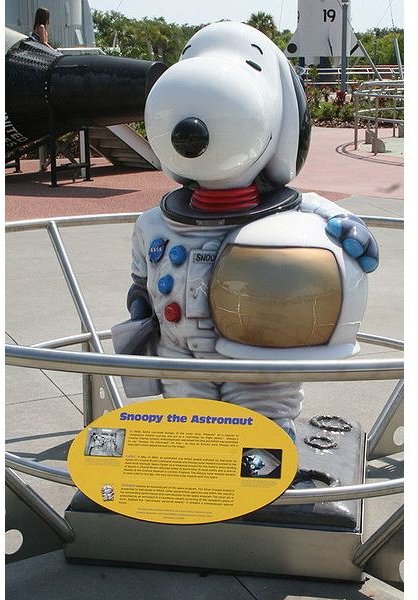About NASA and Mascot Snoopy
Snoopy’s Moon Landing
President John F. Kennedy challenged America to put the first man on the moon in 1961. He probably never imagined that a beagle would be the first to answer his challenge.
With the space race in full throttle in the 1960’s, Peanuts creator Charles Schulz showed his support for the space program by creating a series of strips featuring the character Snoopy, the “world famous astronaut,” landing on the moon. Wearing a helmet in addition to his “Flying Ace” scarf and head gear, Snoopy piloted his doghouse through space.
Snoopy had previously played a WWI pilot, an attorney, an Olympic figure-skater, and Joe Cool, but Snoopy’s astronaut character was his most high flying yet. Being the first beagle on the moon, he had successfully beat the Russians to the moon. Most importantly, he had also beat his nemesis, the “stupid cat next door.” The strip featuring Snoopy on the moon ran on March 14, 1969.
Snoopy the Astronaut
Snoopy and NASA
Snoopy and NASA first began their relationship, prior to his moon landing, when NASA approached Charles Schulz and asked if they could feature Snoopy in an award. After the Apollo One disaster, NASA decided to create a program which would promote safety. Snoopy was chosen to “emphasize mission success and act as a ‘watchdog’ for flight safety.”
This award became known as the Silver Snoopy award, which is an award given to NASA employees who show exemplary accomplishments in the area of safety. The award consists of a silver lapel pin, a commendation letter, and a framed Silver Snoopy certificate.
Considering himself a big supporter of the American space program, Schulz worked out a deal with NASA and United Feature Syndicate, the distributor of Peanuts, to allow NASA to use Snoopy for free for this award. Schulz, who drew every frame of his own comic strip, even designed the artwork for the award and promotional posters. These awards are literally flown through space on space shuttles before they are given to their recipients.
Charlie Brown and Snoopy
The Apollo 10 mission also featured Charlie Brown and Snoopy as unofficial mascots. The lunar module, which was supposed to “snoop around,” was named Snoopy. Fittingly, the command module for the mission was then nicknamed Charlie Brown. The astronauts of the mission, Thomas P. Stafford, John W. Young, and Eugene A. Cernan, also carried sketches of Charlie Brown and Snoopy on board. During the Apollo 10 mission, the Snoopy lunar module was left in lunar orbit, and Schulz created a strip in which Charlie Brown consoles Snoopy over the lunar module named in his honor being left behind in space.
Sources
https://www.nasa.gov/topics/history/features/snoopy.html
https://www.schulzmuseum.org/pressreleases/20081212.html
image source: https://en.wikipedia.org/wiki/File:Snoopy_statue_at_KSC.JPG (RadioFan)
